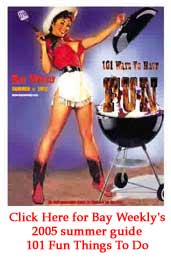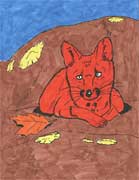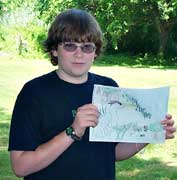|
|
 |
|||||||||
|
Volume 13, Issue 27 ~ July 7 - 13, - 2005
|
||||||||||

|
 Opening the Creative Floodgates Opening the Creative Floodgates For River of Words, young champions think green By Carrie Steele Say the word ‘poetry’ and you’ll make the typical American teenage boy cringe. Or at least tense up with the thought of meter, syllables or even rhythm, picturing a painstaking plow through heavy words and phrases. Or — the most dreaded of all — having to craft his own. But young poets in Chesapeake Country stood up to the challenge, making their watershed home their muse. Bay Weekly caught up with three teenage boys — two poets and one artist — who took the time to chronicle the watershed through their own eyes, each lending their unique vision and witness. They’re not alone. Chesapeake Bay has inspired many an artist, among them Bay photographer Marion Warren; Bay writer Tom Horton; Bay minstrel Tom Wisner. Like such successful artists who have turned to the Bay for a living, each year Maryland students take on the task of reflecting Bay aspects deep and meaningful to them, crafting those sentiments into words or pictures. Spurring these students to voice their inner Bay poet and watershed artist was the International River of Words Poetry and Art Contest, where young minds from all over the world — even teenage boys — can put their Bay-thoughts to the test.
Maryland’s 170 student submissions were first shipped to San Francisco — along with thousands of other entries — to compete in the 10th annual International River of Words Poetry and Art Contest, created by former U.S. poet laureate Robert Hass, who served as the country’s chief poet from 1995 to 1997. Any child in the world aged five to 19 can enter creative words or drawings. The purpose of the contest is to “help youth explore the natural and cultural history of the place they live, and to express, through poetry and art, what they discover,” according to contest rules. Internationally, eight U.S. grand prizewinners, plus an international prizewinner, boast awards, along with 50 poetry and art finalists from all over the globe. Young poets submit poems under 32 lines in English, Spanish or videotaped American Sign Language. Student artists can turn in paintings, photography, collages or anything flat that can be mailed. All of this year’s poetry winners hail from the United States and were judged by Hass himself along with writer Pamela Michael. These poems will then go into a River of Words book compiled by the Library of Congress. Artwork knows no language barriers, so the awards were more international, with the international grand prizewinner a Hong Kong native and finalists from Azerbaijan to McLean, Virginia. These masterpieces were chosen by children’s book writer and illustrator Thacher Hurd, who wrote the children’s story Mama Don’t Allow. Prize art is then exhibited around the world, and River of Words has a children’s art gallery in San Francisco. This year, Maryland claimed an art champion: eight-year-old Salisbury student Holly Records’ drawing called The Big Red Fox. After the international contest, Maryland’s submissions headed home again, eligible for the Maryland State Contest. But even at home, the competition’s still tough.
“That’s their second chance to win,” said Maryland Department of Natural Resources’ Joann Wheeler, who receives Maryland’s poetry and art back from the international River of Words for judging and awarding in our own state. “The River of Words theme is always watersheds,” explains Wheeler, who coordinates the Maryland competition. “But that’s so broad,” she continued. “It can be anything related to the watershed: landscapes, flowers, waterscapes, seascapes; anything relating to nature,” says Wheeler, who finds that Maryland’s young poets and artists naturally use the Bay as a muse. “A lot of them have to do with water: the Chesapeake or fishing. Things they enjoy.” Like canoeing in a marsh. That’s how Severn School graduating senior Mike Gall of Riva found the inspiration for what would win him a ribbon and state fair passes. Watersheds and Their Inhabitants “We have an infinite amount to learn from nature and from each other.” — John Glenn The watershed is not just the land, But everything between the sky and sand. Our rivers form by the precipitation, Which helps with the foundation. Liquid flows from the Cumberland mountain peak, All the way down to the Chesapeake. It gives us all kinds of food, This puts in all in a good mood. The pollution is destroying what we hold dear, So hurry up and be on the frontier. Do your part to clean the Bay, So clean streams will flow everyday. — Mike Gall Gall, just graduated from Severn School, will be out in the watershed as he mows lawns this summer, among other jobs. While he was writing his poem last winter, 170 other Maryland students were also courting their muse. Poems were turned in early this spring for judging. In this statewide round, judges are “usually just people who volunteer within the department or community,” says Wheeler. For Maryland’s contest, 12 such judges chose poetry and art finalists in two age categories: grades kindergarten through sixth and seventh through 12th. Their range covered 10 Maryland tributaries. Next, Maryland’s 21 finalists push on to compete for the top prize: money in the bank. For this final round of state competition, Wheeler calls on the big-name judges: Baltimore Sun columnist and Bay author Tom Horton and Elsie Whitman, co-owner of River Gallery in Galesville. “It was fun to see how the kids perceived something and then put it on paper,” said Whitman, who found awarding finalists a tricky business. “It’s hard to judge anybody who puts out the effort. You want to reward them.” But Whitman judged her entries just as she would any other artwork. “I looked at composition, balance, color, execution of what they were trying to tell you,” she said. “The first-prize winner in the older group really thought it all out and had good composition.” Whitman and Horton name their top choices come August at Natural Resources Day at Maryland State Fair (the first Saturday of the fair), and four Maryland grand-prize winners will claim their champion title: one for poetry and one for art in each of two age groups. Champions receive yet another ribbon and get a $100 savings bond from Sandy Spring Bank. And all the finalists’ artwork and poems will be on display at the fair and then at the Maryland State House in Annapolis from mid-September until mid-October. Horton and Whitman have picked their champions. But mum’s the word about who’ll take home state fair ribbons.
Poems and art are often shaped over time and experience, like a piece of sea glass polished from wave action. Some poems rhyme. Some are short, some are long. Some paint a picture in the mind’s eye. Others tell a story. There’s also a sea of devices: assonance and alliteration, as well as onomatopoeia, form, rhythm and meter. What ties these River of Words poems together is thoughtful consideration and combinations of water thinking. Only 12 young poets made the cut as Maryland judges read their way through piles of poetry submissions to the contest. Severn School, in Severna Park, boasted two poetry finalists: junior Tommy Price and senior Mike Gall. Both began their poems in an assignment for a creative writing course taught by Jackie Baugh. To spur them on, Baugh entered her students’ works in the contest, making the watershed her students’ muse for their assignment. She also sends her students’ works to the Severn River Garden Club’s poetry and speech contest as well as the Soil Conservation District’s speech contest. “The Garden Club has an essay component. We always enter the freshmen,” says Baugh. “I like that the students can receive feedback from outside the classroom. Sometimes the people running the contest see things differently than I do in the classroom.” Topical contests spur students to investigate the world around them, said Baugh, whose brother, Don Baugh, is vice president of education for the Chesapeake Bay Foundation. Before words even began flowing from students’ pens, the head librarian, former English teacher Linda Stone, gave poetical tips on writing. “Poetry can be written on any topic,” Stone said. “When I taught English, there were really just love poems. We’ve come light years.” “Each word counts for more, carries more power” when you’re writing a poem, Stone explained. “Poetry also has a lyrical sound. We looked at what words are poetic sounding,” Stone said. “For instance, ‘marigold’ is poetic, but ‘mugwart’ is not,” Baugh added. “Linda did a whole chart on the difference between prose and poetry.” The lyrical coach also advised the students to use exact naming words. “If they wrote ‘fish’ we’d ask ‘what kind of fish?” she said. “I asked them to remember that we live near the Bay; what are the dangers?” said Baugh. “Kids today are very busy with lots of issues in their lives; it’s nice to give them a chance to think about their environment.” They did, and she submitted 14 poems, one by each student in the class, to try for prizes. Lyrical Currents “Doing the project, it opens people’s eyes,” said finalist Gall, who reports that he had to re-read his poem “about 50 times.” All this revising helped him figure out if the poem worked well and how he could make it flow better. “With a poem, you can put your own creative twist or spin on it. It can tell something very deep. There’s so many ways you can tell about what’s going on in the watershed in a poem,” he explained. Even making revisions and setting it aside make the creative juices flow, Baugh advised her students, encouraging them through the chore of revision. “Your subconscious is working, even if you’re not actually working on it,” she said. Gall’s poem began with experiences both serious and seriously fun. “I first thought about all the information I’ve learned at school, when we went on field trips; and then I thought about all the fun I’ve had in the water with my friends,” said the young poet, who will be a freshman at Anne Arundel Community College in September. He reached back into memory for inspiration: a canoe retreat, where he learned about the importance of marshes and glimpsed wildlife in and out of the water. “Most people don’t know that it’s this big watershed. You have to take care of everything to maintain an ecosystem,” said Gall, who lives in the Lower Western Shore tributary system. “I was actually thinking about the flow of the water from the Appalachian Mountains to the water that creates the Bay. “I want it [the watershed] to be around for my kids, and the kids after that,” Gall said. “I tried to tell the message that people need to fix it up and not to take it for granted.” Classmate junior Tom Price, from the Patapsco watershed, began writing down his eco-thoughts with a yearning for warmer weather so he could get out on the water. “It was the dead of winter, and I was already thinking about the spring season,” said Price. “I’m a fisherman; I fish for rockfish. I was just waiting for spring,” he said, until he could finally cast his line. Price used a quote from the Chesapeake Bay Foundation’s State of the Bay report as an introduction to his poem. “I saw the quote on an e-mail, and it’s a little depressing, I think,” said Price about the outlook on the Chesapeake’s health. “It’s going uphill. It’s being improved, but not tremendously.” The Chesapeake Cycle “Our work and the will of the people not withstanding, our reports have pointed out that the Bay’s health has lingered perilously at about one-quarter of its potential for the last seven years.” —2004 State of the Bay Report Introduction The summer sun sets Over the Chesapeake Bay, Yet one forgets What continues today The water still flows Through day and through night, Draining all that compose Of the Bay at its height Fish will keep swimming And the oysters filter on, While the light begins dimming, Waiting til dawn The Bay provides life For all of the land, From the tiny alewife To the terns on the sand From the hills and the fields The water runs down, Providing the meals That feed your small town To save the Bay Should not be a chore, So remember each day What we need to restore. —Tommy Price
Creative poems and new ways of phrasing nature captivate our minds with words. But visual images associated with our watershed ecology are just as striking: peachy sunsets, the quiet heron, sparkling streams and breezy sailboats. So art is just as powerful. Seventh-grade artist Chris Smith, from the Summit School in Edgewater, has been drawing since he was three. Many of his drawings feature comic characters and cartoons. His current masterpiece is a two-foot-high pencil drawing of Yosemite Sam and Elmer Fudd. Last year, he won as an art champion for his age category in the River of Words poetry contest. “Chris can look at things differently than other people, in the way that he can see something and draw it,” said his mother, Sharee Smith. “He’s taken lessons at Maryland Hall, and with art teacher Stacy Allen at Bay Arts Center.” Chris said he drew Heron’s Home especially for the contest. His inspiration came from wakeboarding and tubing in the West and Rhode rivers, said Chris. “And my mom gave me some ideas,” he allowed. “There’s this one place on the West River Estates where there’s a fallen down tree where turtles have crawled up on the log,” said Chris. Out on the water, he’s seen snakes and recounts a tubing trip, where he and a friend fell off the tube. “We saw this thing in the water and thought it was a snake. They told us it was just a stick, and we calmed down to get out of the water. Then later they told us it really was a snake,” said Smith. He and his mother and brother Robby tell of the white herons, owls and even an eagle that comes flying through their neighborhood — in addition to turtles, salamanders, jellyfish and jumping fish. Chris credits older brother Robby with explaining to him what wetlands were. It’s the watershed where animals live, said Chris, in summary. That’s a lesson he drew on paper. Nature’s a pretty common topic for Smith and fellow artists, he says. “Yeah, a lot of people like to draw animals.” For Chris, drawing is its own reward. Still, he doesn’t mind recognition. “I was excited,” Chris said about getting the letter that he was a finalist. “And surprised. I didn’t think I’d get it two times in a row.” There are also free tickets to the fair and free bagels, says Chris, who also won an honorable mention in this year’s Annapolis Symphony Orchestra Art Contest and was chosen Summit School’s yearbook cover artist. Claiming the Prize Gall, Price, Smith and the other 18 finalists will take their art to the next level on August 27, when they’ll compete at the Natural Resources Day at the Maryland State Fair. On fair day, four champions in Maryland River of Words will take home ribbons and prizes. It’s not a crown of laurel, but it’s the currency that counts at the State Fair. See all the finalists’ works online at: www.dnr.state.md.us/education/are/row/2005finalists.html. International River of Words Contest: www.riverofwords.org.
|
|||||||||
|
|
||||||||||
|
© COPYRIGHT 2004 by New Bay Enterprises, Inc. All rights reserved. |





 About the Author
About the Author